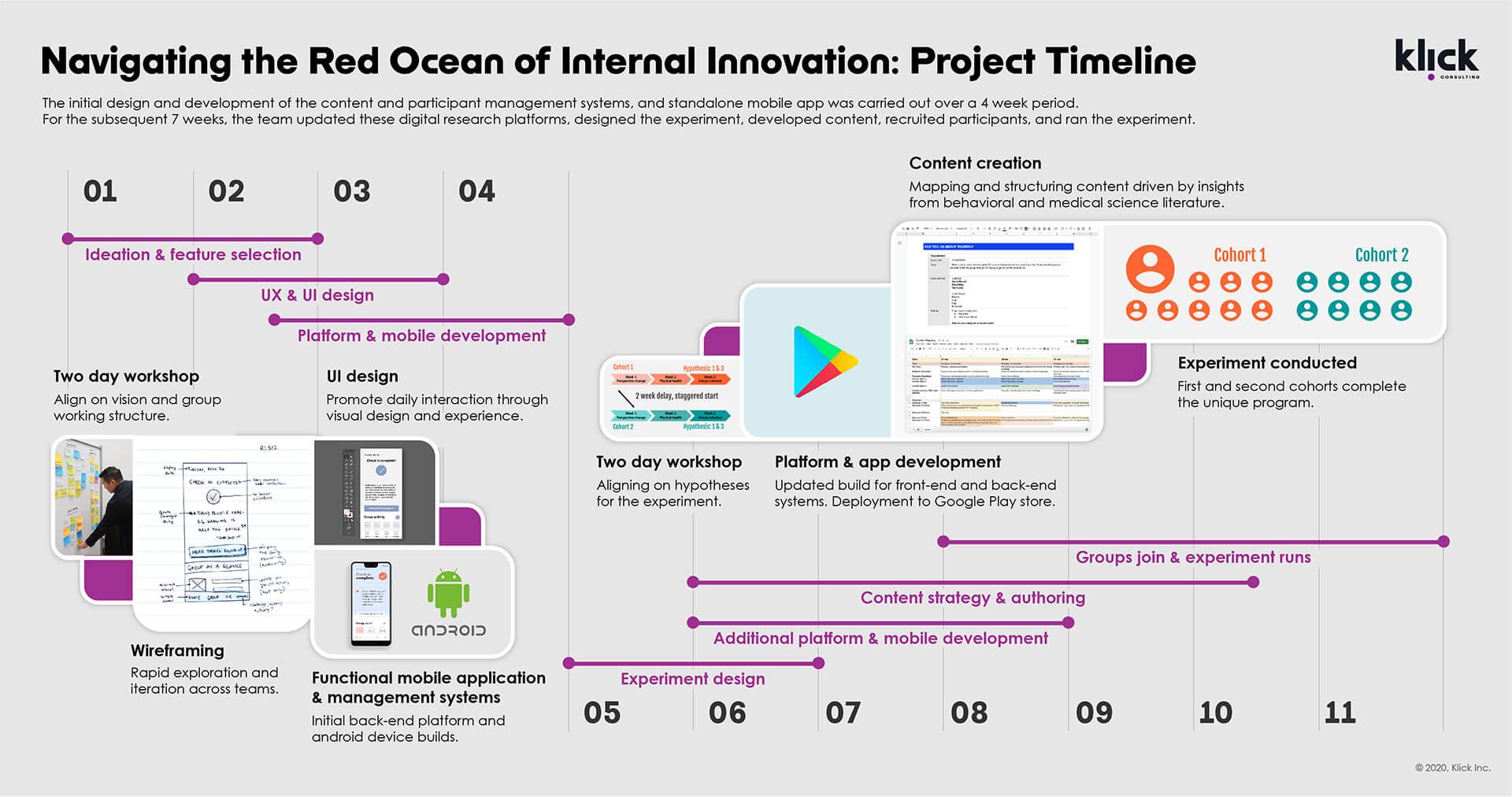
Case Study
Navigating the Red Ocean of Internal Innovation
A New Meaning of Health in Chronic Conditions
Our client was an innovation group within a multinational life sciences organization possessing extensive experience in a variety of therapeutic areas. The group was mandated to “disruption-proof” their organization. In practice, this meant working within an established therapeutic category to identify opportunities for novel interventions or underserved populations.
Our client’s challenge was typical of internal innovation groups: needing to “think big” and take chances while also demonstrating ROI and an obvious path to market. We were engaged to help them accelerate their exploration and deliver value within one of the organization’s key categories: a chronic condition affecting hundreds of millions of people world wide.
Their past research showed that most interventions had focused on addressing the physical symptoms of the chronic condition. This neglected the negative impacts on mental and social health that often accompany a chronic illness. This presented a unique opportunity to support the mental health of those living with the condition by having them learn from one another, form a community, and thrive. While the general value proposition was easy to articulate, we needed to find a way to make the idea tangible, evaluate it, and to do it all as quickly as possible.
From Insight to Action
At Klick Consulting, we know solving our client’s complex problems cannot be accomplished by any one skill set or subject matter expert. Instead, it requires the combined, coordinated efforts of scientific expertise, business acumen, and strategic design.
- Align on the most promising area of exploration for a novel intervention
- Determine how to evaluate it
- Develop, build and test the intervention in market
To best deliver against this, we assembled a dedicated team of scientists, designers, and engineers. Our first action was to draw insights from behavioral and medical science literature so that we could more fully understand the needs of these individuals.
We quickly realized that there was no benefit in creating anything that resembled a traditional “support group.” Support groups already exist and they have a number of shortcomings. However, we wanted to be able to leverage the very real strength of communities. For the intervention to be successful, this real contradiction needed to be resolved. To do so, we applied our behavioral science expertise to draw inspiration from a variety of sources within the social psychology literature on group formation. These insights helped us define some of the attributes of a novel, potentially effective, solution.
These features and constraints focused the precedent research conducted by our design and business consultants. We were able to find analogous solutions from related disease states and other industries.
In tandem, our development team had been exploring technical components, both custom and “off-the-shelf,” that would provide the most direct path to a testable asset.
This collaborative way of working extended to our client team. With them we formed an agile, effective working group. Collectively, we were able to quickly articulate and align on the specific value proposition of the support community and the method of intervention.
Design and Development
The solution needed to be validated through a dedicated digital research platform. Core requirements included content and participant management systems and a standalone, mobile interface for end users. Using our collaborative design and development process, our team was able to produce the research platform in just four weeks.
We then worked with our client to refine our goals for the in-market experiment. To maintain user engagement, it was clear we would need novel, daily content delivered through the platform. Our research had already provided us insights on how sufferers could mitigate some of their physical and mental health challenges. We converted this into a multi-week curriculum.
After 7 weeks of technical and content development, we had progressed from our client’s initial hypothesis to a full research platform, complete with a mobile app in the Google Play store.
Testing and Preliminary Results
The application was tested for several weeks with cohorts of individuals living with the chronic condition. Each day they interacted with the application, the content, and one-another. Our research platform used a custom dashboard to analyze all of these data points on a daily basis. Based on the principles drawn from behavioral science, we adjusted the content to best prompt group formation and sharing.
At the end of the experiment, we evaluated the engagement and perception of the app through usage data, a quantitative feedback survey, and qualitative interviews. Most users found the application extremely beneficial and many were willing to pay for it. The engagement and feedback confirmed that there is a real gap in chronic conditions management that our intervention was able to address.
Delivering Disruption
Internal innovation teams have an extremely challenging role. They need to take big risks while demonstrating a clear return on investment. And they need to do it quickly.
With our client, we used insights drawn from science to identify opportunities to improve the health of real people. Based on these opportunities we strategically designed and implemented a solution. We then tested this solution in the real world and started to build a business model to support it.
Through our collaborative, multidisciplinary approach, we were able to move from an initial hunch to a proof of concept with a clear path to commercialization.
About the Team
- A Behavioral Scientist
- A UX Designer
- A Communication Designer
- A Strategic Design Lead
- A Technical Architect
- A Technical Lead / Data Scientist
Project Timeline
The initial application design and development was carried out over a 4 week period. The team then designed the experiment. We then developed content and recruited participants over the next 3 weeks. The experiment focused on 4 weeks of testing with real users.


Delivering at speed meant rapid iteration: identifying additional requirements, drafting wireframes, designing interface elements, and integrating them into the proof of concept platform.